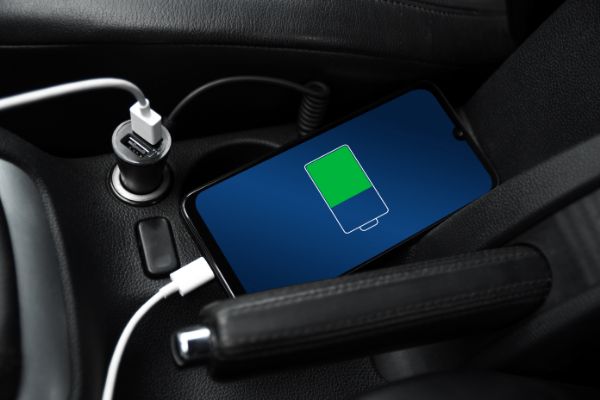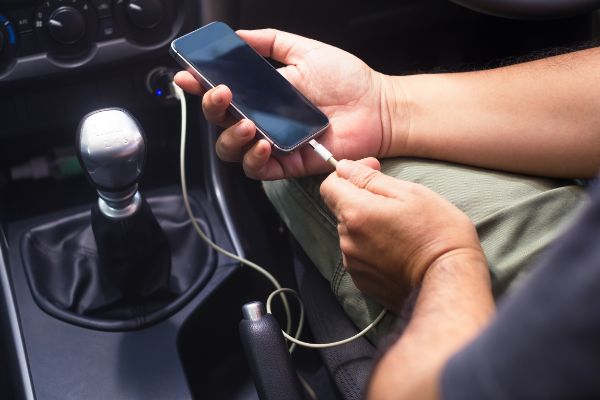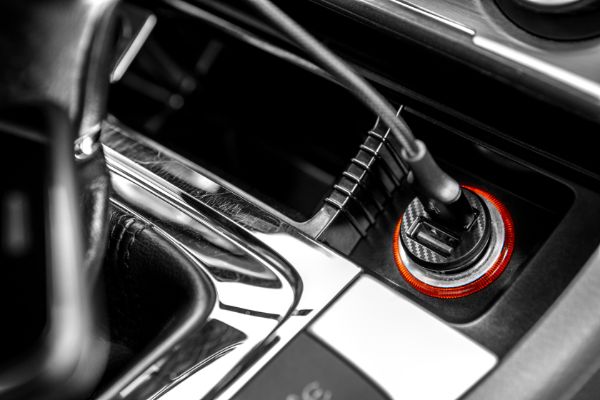Disclaimer: This post may contain affiliate links, meaning we get a small commission if you make a purchase through our links, at no cost to you. For more information, please visit our Disclaimer Page.
Smartphones represent some of the most versatile devices that people use today. They are both entertainment and business devices. Additionally, they can help us schedule and keep track of our personal lives, or they might perform complex calculations that are on par with a much larger computer.
In short, these devices can be invaluable helpers that we get to carry conveniently in our pockets while we’re out and about on daily business or relaxing at home. In any case, it is important for us to have a way to keep the batteries on our phones charged up and ready to go.
While it might be common to plug your phone into a compatible charger and outlet whenever you get home, you’re not always in a position to do this when the battery on the device gets low. If you still need to use your smartphone throughout your day, you might have to charge it more than once in the time since you leave home. One of the ways to do this is via car phone charger.
Some phone owners who are thinking about getting one of these chargers might wonder how they work. This is the topic we will cover in today’s article. As we go along, we will also dig into the specifics of phone chargers.
Some of these topics might include whether it is okay to leave them connected to phones all the time, or how much extra gas, if any, they might take in order to power them. Similarly, we’ll also talk about the effects of car chargers on vehicle batteries, and whether the devices can still charge phones without any power going to the car.
Table of Contents
How Does a Car Phone Charger Work?
Your vehicle uses its own battery to charge the various electronic things that it needs to use while it is in operation. Any digital or powered accessory or feature in your car needs to draw a current from the battery, and the same is true of your smartphone.
If you need to charge your phone while it is in your vehicle, you’ll plug a special charger into the car itself. This charger will have an end port and adapter that are both somewhat different from what you might be used to on the standard charger that you have for your phone.
In the case of a car charger, you’ll plug one end of it into a large, circular port on the dash of your vehicle. Nearly all modern cars should have this kind of port available in the form of a lighter, but it is possible that you have a model for which the manufacturer intends a different use for the port.
Because car chargers are so common nowadays, some vehicles might come with ports that the designers developed just for charging. Other cars may put the proper input location for a car charger in a place other than the dash. Still others might have technology that could allow you to charge your phone wirelessly, too.
However, car chargers have specific adapters. Just like when you plug in your phone to charge it at home, the current that runs through a car battery is too high for the electronics inside a typical smartphone to handle it. If you were to run this current through a phone in its unmodified state, it would overload and damage the circuits inside the phone, possibly to an irreparable degree.
Therefore, the adapter in a car charger converts the power of that current to a lesser form that a phone can handle.
Your phone’s car charger will take some of the juice from the vehicle battery, downgrade it to an acceptable voltage, and use that power to bring a charge to the battery inside your smartphone.
Do Car Phone Chargers Use Gas?
Yes, car phone chargers that you use will burn a bit more fuel than if you chose not to plug your phone in at all. We spoke about how the car is getting a charge from the battery, which is true. However, your vehicle’s engine needs to work slightly harder for any increase in battery current that it needs to draw.
To be a bit more precise, the car engine might require slightly higher torque in order to get the alternator to turn. The car charger creates a field that runs counter to the direction of a vehicle’s alternator.
All of this might sound like hard work for the car’s engine, but we’re just focusing on the possible impacts of a car charger. In this case, the true amount of extra work or energy the car might need is so small that most people would consider it almost negligible. A gallon of gasoline should account for several kilowatt hours of energy that the car can burn.
At best, your car’s phone charger might need to pull about five watts continuously in order to bring a charge to your phone’s battery. This is an extremely small increase in the necessary energy the car’s battery and gas tank might need to provide for the convenience of topping up your phone.
In truth, there are several other things that can affect your vehicle’s mileage or gas efficiency in far more obvious ways than just the act of charging your phone. How smooth your overall driving experience is, how often you can cut down on unnecessary distances, how many times you need to start moving the vehicle again from an idle state in traffic, and what other things you need to access using the car’s power all play different roles in how much gas you get out of a single tank.
Is It OK To Leave a USB Charger Plugged In and Active in a Car?
Typically, it should be fine to leave a car charger plugged in when it is in the vehicle. This is true whether you keep the phone plugged in to the charger itself or not, but there are some differences in power draw with either scenario. Some models of cars have switched sockets and some do not.
For switched sockets, the car should put those ports to sleep after some time when you have not used them. In such cases, the devices that you connect to those ports should draw no power.
Even if you have a vehicle with a socket that does not switch itself off after some time, any kind of power draw from leaving your car charger in the port should be almost infinitesimally small. Most modern smartphones will stop charging the battery when the latter reaches its full capacity. This alone will stop the device from drawing more current than it needs and draining the car battery.
If you choose to take your phone with you, the charger is sure to only draw enough energy to show a LED light that might indicate an active connection with your car. Other ports in the vehicle may shut themselves off instead. In these scenarios, you would not even see the light on the charger until you started the car again.
The only way that a car charger in a car might be a problem for the battery is if you left it connected to its charging port for many months without starting the car again in all that time. When something like this happens, there is a possibility that it could drain the battery slowly over such a long period.
However, as long as you start and use your car periodically, having the charger plugged in to any port on it should not have an effect on the vehicle that you could measure in any meaningful sense.
Do Car Phone Chargers Work When the Car Is Off?
It may be possible to charge your car when the vehicle is not active. In this case, you would just use battery power to bring a current to the car charger, change it over to an acceptable voltage, and give power to the smartphone’s battery. However, this ability can depend on the make and model of the vehicle itself.
In some cars, the socket into which you can plug a car charger still receives power when you turn off the vehicle. In others, that same socket takes its cue from the ignition of the car’s engine. If you have one of the former types of vehicles, you should have the option to charge your phone when the car is not active.
Most reputable chargers have some kind of icon on them that will light up when they are bringing a charge to the phone. You can look for any such indicator to see if your car is able to charge up your phone even while the vehicle is off, but there is a caveat to watch out for here. Some inexpensive chargers may use components or construction that are not up to a good standard.
With these products, there could be some risk to your phone, car battery, or both should you choose to leave the devices plugged in while you’re not around your car. In these cases, a poor charger might short out, smoke, or cause irreparable damage to the batteries of both systems. It is a good idea to purchase and use only chargers that reputable manufacturers make specifically for use in vehicles.
Does Leaving a USB Device in a Car Drain Battery?
If you’re only leaving the device itself plugged in, it should use almost no battery power from the car at all. It might use an extremely small amount of power to give some energy to the LED indicators that the charger might have on it.
Otherwise, there is nothing that the car needs to bring power to using its internal battery. Any significant battery drain that would be noticeable to the car’s owner would have to happen over a very long period, and most people will remove or replace their chargers before this kind of thing can happen.
Conclusion
If you need to charge your phone when you aren’t home, having a car charger handy can be a great alternative. While the vehicle needs to expend just a bit more energy to add a charge to the phone, it is usually worth it to make sure such a crucial device has the power that it needs in order to help you stay connected to the different aspects of your business and personal ventures.



